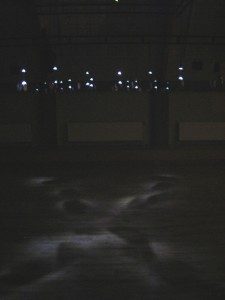Multi-channel radiophonic performance (40 min) and/or installation (2006-2008)
Premiered at Radio Revolten Festival, at Ärtzehaus in Halle, Germany; 3. October 2006. Installed at Radiophonic ‘07, at Les Brigittines Contemporary Art Center for Movement and Voice in Bruxelles, Belgium, October 2007; and Art+Communication: Spektropija, at Riga Art Space in Riga, Latvia, October 2008.
LISTEN TO AN EXCERPT entitled “INHALE/SUSPEND” on SILENCE RADIO
Many thanks to Canada Council for the Arts, Media Art and Audio Art Section; and to Conseil des arts et des lettres du Québec for financing the touring of this work in 2006, 2007, and 2008.

The radio of the future as imagined by the past was filled with the promise of extra-ordinary extra-territorial union across distance and time. Spiritualists and scientists ardently hoped radio would allow access to realms of the uncanny; some believed that the radio would provide a connection with the dead or other ethereal spirits. The radio of the present is filled with reports of the dead: twenty casualties from this attack, thirteen from that accident, one dead, four lost in rough weather, hundreds buried by a landslide. Rather than dream again of the radio transmitting messages from those who have passed away, I wondered what communication we might be missing from those living around us. What nearly inaudible signals, transmitted in moments of intensity or crisis– what do people seek to transmit, in a moment between the intake of breath and the breath held, waiting, in tension?
You are far from us is based on a radiophonic array consisting of 4 low-watt FM transmitters, and 60-100 pocket-sized radio receivers, all suspended approximately 1.5 meters above the floor in a nearly black space, lit by small LED lights. The piece is a four-channel composition, with the radios each tuned to one of four FM frequencies broadcast from the transmitters, such that the radio array constructs an immersive, dynamic sonic environment, where sounds are felt to be both near and far. As a performance, it contains five movements: inhale, suspend, witness, nocturne, exhale. Built on breath and other bodily exclamations typically absent from regular radio broadcasts, the radios operate at the limit of their capacity to transmit emotion. Voices in the piece are sampled from eye witness and survivor accounts of people confronted by assailants with guns. Other sampled sound sources include theremin, accordion, and stopwatch. Finally, the radio transmitters themselves are tuned so that there is overlap between transmitters, causing the receivers to twitter and oscillate with sounds created by the interactions between transmitters, receivers, and audience members. As people walk among the radios, their bodies also cause sudden eruptions of static and signal.
This piece is devised to be both an installation focussing on the static oscillations between transmitters, receivers and bodies, and as well looped breath), and a performance. The performance is not so much about watching me as a performer (though I am seated in the room and visible, I’m not presented as a visual focal point for the audience), but more about experiencing sound in a cinematic fashion– there is a beginning, middle and end to the piece. I direct live-generated and pre-composed sounds through the four transmitters to the receiver array. The performance is 35 minutes, while the installation runs on a 25- minute loop.
This work aims to create an intimate and affective soundscape that is at times anxious, urgent, pensive, or lyrical. Sources for composition include non-verbal utterances, fragments of spoken text, tiny samples of live witness reports taken from radio news, interfrequency signals, interference, accordion, harmonica and theremin. The sound of human breathing lays the groundwork for the composition: breath recorded over baby monitors, walkie-talkies or taken from mobile phone calls broadcast on conventional news radio, that are then compressed and degraded to be rendered both fragile and monstrous. Through the emphasis on breathing I seek to hear the bodies and uncontrollable emotions of those transmitting. These nervous/affective sounds are framed by more abstract sounds created from instruments that mirror the human breath (accordion, harmonica) or the detuned radio landscape (the interference sounds from the different transmitters).
![]()
